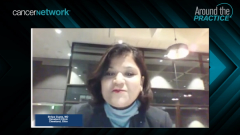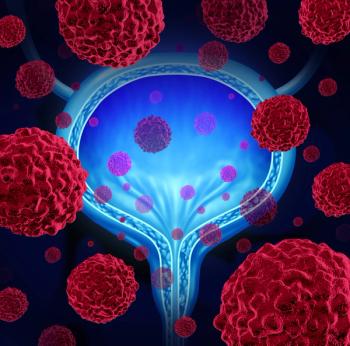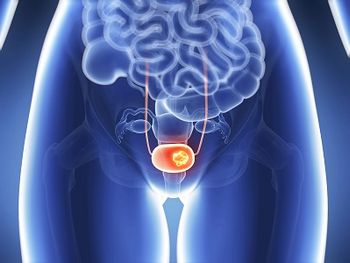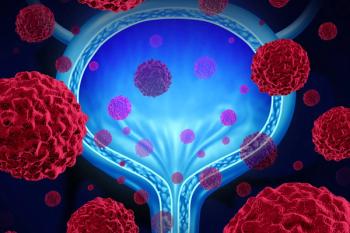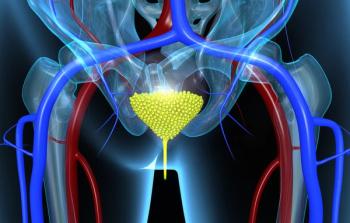
Selecting Second-Line Therapy for Metastatic Urothelial Carcinoma
Expert perspectives on the selection of second-line therapy after a patient has progressed on maintenance avelumab.
Episodes in this series

Transcript:
Peter H. O’Donnell, MD, PhD: Let’s evolve this patient’s case a little bit and move on to our next discussion. We have the same 68-year-old man. Remember, he’s got metastasis in the lymph nodes and lungs. PD-L1 is high. Crowning clearance [is] 65. ECOG is 2. You’ve got GemCarbo [gemcitabine carboplatin] for 6 cycles and attained a partial response on avelumab maintenance. Then 9 months into avelumab maintenance, he unfortunately has new liver metastases. You have next-generation sequencing results and, unfortunately, no actionable mutations.
Let’s first ask our audience: How would you treat this patient now? There are a lot of options here. Would you use enfortumab vedotin? Would you use erdafitinib? Pembrolizumab? Nivolumab? Would you use sacituzumab govitecan, some single-agent chemotherapy, or would you rechallenge with platinum-based therapy? Please choose 1.
Looks like we’ve got most answers now. We’re getting about two-thirds of the audience picking EV [enfortumab vedotin] as their treatment choice. Then we seem about evenly split between pembrolizumab, nivolumab, and sacituzumab govitecan. And a few folks are saying they might rechallenge with platinum. I’m going to open this up to the panel. We can start with Cora. What would you pick, and can you defend it?
Cora N. Sternberg, MD: I clearly would pick EV, an antibody-drug conjugate. Its target is nectin, it’s protease cleavable, and its payload is monomethyl auristatin E. It’s very effective in patients who have already had chemotherapy and who have already had immunotherapy. The problem with it is [that] it does have toxicities and the patients initially feel very well on it, but many of them have skin toxicities. The worst toxicity I see, or have happened eventuallyif patients are on it long enough, is peripheral neuropathy, which can make it hard to walk. Sometimes I have to beg my patients to get them off it because they feel so much better, in terms of their tumor shrinking or going away, that they don’t mind the fact that they’re falling down, having a car accident, or breaking their wrist when they fall, so I must be very careful with the peripheral neuropathy with that. It’s a great drug. It might even move into the first line with pembrolizumab, but we’re going to have to be really careful in learning how to manage that peripheral neuropathy and knowing when to stop.
Peter H. O’Donnell, MD, PhD: Since you brought it up, let me ask you a follow-up. Say your patient had some moderate peripheral neuropathy from their prior platinum, is that an absolute contraindication to EV?
Cora N. Sternberg, MD: I don't think it’s an absolute contraindication, but I think it needs to be looked at very carefully. I’m often lowering the dose of the EV, and I’m often trying to send them to the neurologist. I’m trying to give them medicines to help the peripheral neuropathy, but when it gets too bad, I’m usually the one that says you have to stop now before you get hurt. The peripheral neuropathy is a little different than what they had with platinum.
Peter H. O’Donnell, MD, PhD: Great. Shilpa, what did you pick and why? Is the patient progressing?
Shilpa Gupta, MD: It would depend on how bad their peripheral neuropathy was after cisplatin or carboplatin, because peripheral neuropathy is really bad with this. Once it happens, there’s really no medication to reverse it. So if patients have some degree of neuropathy after platinums and they have liver metastases, where we know enfortumab has great activity, I sometimes start at a lower dose and, instead of 3 weeks [on] 1 week off, I do 2 weeks on 1 week off just to play around with it. And like Cora, I am very quick to interrupt dosing and reduce, even though patients may sometimes protest if they are feeling better. We’ve seen that, even with dose reduction, the responses continue, so it’s important to modify the doses based on patients’ symptoms.
Cora N. Sternberg, MD: They also have [weird] skin toxicities. I had one patient who literally turned black. I mean, he was black. When he stopped the EV, his skin went back to its normal color, but it was really weird. No matter how much sunblock I told him to put on—it wasn’t the sun at all.
Shilpa Gupta, MD: They’ve seen fatal reactions, too, now. Yes, you’re right. That’s a big deal now with enfortumab; making sure patients are tolerating it.
Cora N. Sternberg, MD: It’s a really good drug, but it’s like chemotherapy. It has its toxicities.
Peter H. O’Donnell, MD, PhD:Matt, since we’re talking about EV, I’ll ask you. We have the EV-301 trial [NCT03474107], which was that classic third line space up against taxing chemotherapy, and we saw the overall survival benefit there for EV. It’s the only drug that has shown overall survival benefit in the third line space. Is that a differentiator for you, or is it something else?
Matthew T. Campbell, MD, MS: It is. EV is an extremely active drug. We recently participated in a study and found response rates very similar to what was on the study, so it’s a very impressive agent. I will say, though, that if we changed the circumstances and the patient did have severe peripheral neuropathy, and if you could consider going with sacituzumab and potentially spare EV for later—but with the patient as described—EV clearly is the winner in this scenario.
Cora N. Sternberg, MD: I think sacituzumab govitecan is behind in their development, so they’re now just starting that same phase 3 trial comparing with chemotherapy of choice in patients who have failed platinum or immunotherapy. And they’re even allowing patients who have had EV first to get sacituzumab govitecan, so they’re behind in their development. The drug is an interesting drug, too. We can’t compare one with the other. The main toxicities here have to do with neutropenias and cytopenias more than peripheral neuropathy.
Peter H. O’Donnell, MD, PhD: Shilpa, I’ll throw you this tough question. Clearly, some folks in our audience love the FGFR [fibroblast growth factor receptor] alteration patient, so the question is: If you knew this same patient, and they’re progressing through avelumab maintenance after platinum, but you knew they had an FGFR alteration, would you go ahead and use erdafitinib instead of EV?
Shilpa Gupta, MD: I think there is no right or wrong answer. In a patient’s journey, we should try to give each drug when it fits the needs. If, let’s say, a patient has bad neuropathy coming out of a platinum regiment, I would use erdafitinib first and then use enfortumab later. But at some point, we should be able to give both the drugs in a way that patients can get the maximum leverage. Having said that, erdafitinib is not an easy drug to give either and requires a lot of dose modification [and] a lot of nagging toxicities. In fact, we get more calls from patients when they are on erdafitinib than on any other therapy.
Transcript edited for clarity.
Newsletter
Stay up to date on recent advances in the multidisciplinary approach to cancer.



